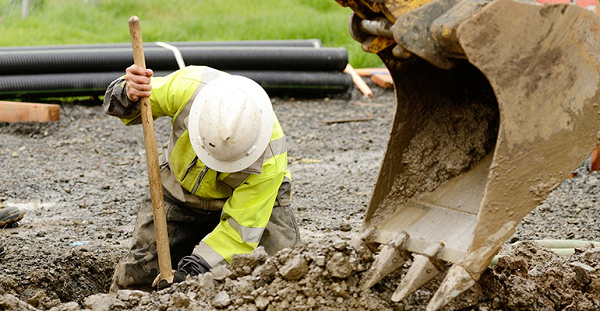Excavation work can be a dangerous activity on the work site if proper precautions and training are not implemented correctly across all workers. And when you add the numerous staff members on site, visitors, site limitations and locations, it’s no wonder that risk management and assessment is essential for all excavation projects.
All managers and those in charge of excavation sites and projects are obliged to follow laws and safety measures in order to ensure the safety of everyone involved on and around the site. Training should also be conducted to ensure everyone understands the dangers, risks and precautions to take when undertaking excavator work.
Researching the site
Before beginning any kind of excavation work, research on the location and depth of any pipes, cables and essential services must be performed. This information must be obtained and provided to those who will be working on the site. Details of all of these underground services should also be kept on hand and readily available for inspections when necessary.
If there is a notifiable incident, these records will need to be kept for at least two years. Otherwise, this information can be kept for the duration of the works being carried out. Keeping this information on hand will help in the event of an emergency, accident and/or to make sure excavation works do not interfere with other services.
The national referral service Dial Before You Dig helps to prevent disruption and damage to essential services and to help make excavations safer for everyone involved. The enquiry will need to be completed at least two days before your site project begins. Having the right knowledge and details of infrastructure and services underground will avoid risks, damages and services being affected.
Identifying the risks
Because there are risks associated with excavations, the risks must be managed in a timely and efficient manner. Some of the risks that can occur with excavations include (but aren’t limited to):
- - Falls into an excavation; either persons falling, or equipment and machinery.
- - Workers being struck by falling objects
- - Exposure to airborne contaminants
- - In worst case scenarios, worker/s trapped in a collapse of an excavation site.
Because different excavation sites will have their own issues and risks, it’s important to determine the risks associated with each individual excavation. The type of excavation being carried out, how workers and visitors enter and exit the site and varying options for carrying out the work are all matters to be investigated at the time of work commencement.
Various hazards may be more prevalent than others depending on the site. However, some general hazards to look for include hazardous chemicals that may cause health and safety issues for workers, possible inrush of water or other liquids, difficult manual tasks or inappropriate placement of excavated materials.
Risk assessments of the work area
Risk assessments aren’t compulsory under Work, Health & Safety regulations for excavation work, (though it is required for certain situations, such as when working with asbestos). However, a risk assessment can be very useful when looking at which control measures will be beneficial to utilise on the site. A risk assessment can also help to determine:
- - Which workers, if any, are at risk
- - Which sources and processes are putting those workers at risk
- - What control measures are best to be implemented
- - If current control measures are adequate.
Associated risks can vary greatly from site to site. Even aspects such as the local weather conditions can have a huge impact on certain risk factors.
Controlling the risks
The primary goal when looking at risks on the construction site should be to eliminate the risk completely. However, this isn’t always possible or feasible. In this case, looking at the control measures that may be used and ranking them by reliability, efficacy and protection is what is known as a hierarchy of control. From here, deciding on the best control measures for the project is made simpler.
Minimising the risks can be done by using one or a combination of the following:
- Substitution - Substitute potential risks or hazards with other equipment or methods. For example, using an excavator instead of explosives for an excavation site.
- Isolation - Isolating the risks can be a good way to keep the area and people in it safer. For example, using barriers to stop pedestrians getting on contact with workers and/or equipment.
- Engineering controls - Using technology and engineering methods to help eliminate risks is often required for many sites. For example, benching, shoring or battering a trench to stop it from collapsing.

Excavating Trenches
If a trench will be greater than 1.5 metres deep, or if mobile plant is being used in and around an excavation, a safe work method statement is generally required. Preventing unauthorised access (including accidental access) is also necessary.
All sides of the trench must be supported by shoring, benching or battering. Otherwise, written advice from a geotechnical engineer who can say all sides of the trench are safe from collapse is needed.
Creating an emergency plan
Although you never want an accident or emergency to occur, planning for one is highly important. In the event of an incident or emergency, an emergency plan that includes an evacuation plan must be thoroughly prepared. Such emergencies may include gas leaks, contaminant spills and leaks, flooding, and rescuing persons from within the excavation site.
Keeping everyone safe
The most important aspect of an excavation is to make sure everyone involved stays safe, and the potential risks and hazards are contained or eliminated (where possible). With the right knowledge and the correct assessments, excavations can be carried out as safe as possible.
If you need help with your next project, DIG IT would be happy to help, get in touch with us today to discuss your needs.